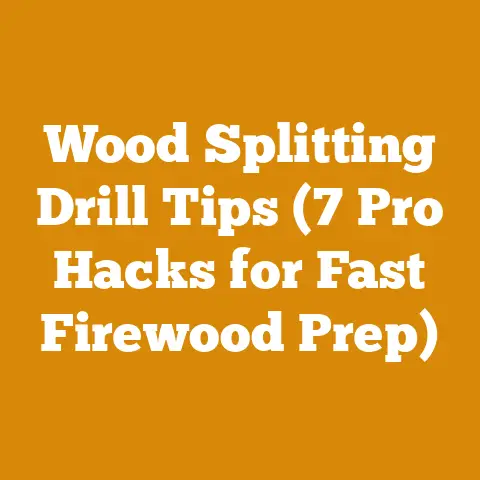Temperature That Wood Burns (7 Critical Insights for Better Firewood)
Have you ever wondered what makes a roaring campfire so mesmerizing? Or perhaps you’ve puzzled over why some wood burns hot and fast, while others smolder and barely give off any heat? The secret lies in the temperature at which wood burns, a critical factor that influences everything from the efficiency of your wood stove to the safety of your fireplace.
I’ve spent years in the woods, felling trees, splitting logs, and stacking firewood. Through trial and error, I’ve learned that understanding the science behind wood combustion is essential for anyone who relies on wood for heat or recreation. This isn’t just about tossing logs into a fire; it’s about mastering a craft, respecting a resource, and staying safe.
Temperature That Wood Burns: 7 Critical Insights for Better Firewood
1. Understanding the Combustion Stages: A Temperature-Driven Process
Wood doesn’t just burst into flames; it undergoes a series of carefully orchestrated stages, each dictated by temperature. Understanding these stages is crucial for predicting how your firewood will perform and for troubleshooting any burning issues.
- Drying (Up to 212°F / 100°C): The initial stage involves evaporating moisture from the wood. This is why seasoned wood burns much better than green wood. The energy required to boil off the water effectively steals heat from the fire, resulting in a cooler, smokier burn. Ideally, firewood should have a moisture content of 20% or less for optimal combustion. I’ve found that using a moisture meter is invaluable for determining when wood is properly seasoned. I aim for readings between 15% and 20% before I consider wood ready to burn.
- Pyrolysis (212°F – 750°F / 100°C – 400°C): As the wood heats up further, it undergoes pyrolysis, a process where it breaks down into volatile gases and charcoal. These gases, primarily methane, hydrogen, and carbon monoxide, are what actually burn with a flame. The higher the temperature, the more volatile gases are released. Different wood species release different amounts and types of gases, which contribute to their unique burning characteristics. Softwoods, like pine, tend to release more gases quickly, resulting in a hotter, faster burn. Hardwoods, like oak and maple, release gases more slowly, leading to a longer, more sustained burn.
- Combustion (Above 750°F / 400°C): This is where the magic happens. The volatile gases released during pyrolysis mix with oxygen and ignite, producing heat and light. The temperature of the combustion zone can vary depending on the type of wood, the amount of oxygen available, and the design of the fire. A well-ventilated fire with dry, seasoned wood will burn hotter and more efficiently.
- Charcoal Burning (Above 1100°F / 600°C): Once the volatile gases are exhausted, the remaining charcoal continues to burn, producing a steady, intense heat. This is why a bed of hot coals is so valuable for maintaining a fire. Charcoal burns at a much higher temperature than the initial flames, providing a consistent source of heat.
Takeaway: Recognizing these combustion stages allows you to control the fire more effectively. By ensuring your wood is properly seasoned and providing adequate ventilation, you can optimize the burning process and maximize heat output.
2. The Ignition Point: When Wood Catches Fire
The ignition point is the temperature at which wood spontaneously bursts into flames. This temperature varies depending on several factors, including the type of wood, its moisture content, and the presence of any accelerants.
- General Ignition Temperature: Generally, wood ignites at around 572°F (300°C). However, this is just an average. Some woods ignite at slightly lower temperatures, while others require higher temperatures.
- Influence of Moisture Content: Moisture content significantly impacts the ignition point. Wet wood requires more energy to reach its ignition temperature because the water must first be evaporated. This is why it’s so difficult to start a fire with damp wood.
- Role of Accelerants: Accelerants like kerosene or lighter fluid lower the ignition point of wood, making it easier to start a fire. However, using accelerants can be dangerous and should be done with extreme caution. I strongly recommend avoiding accelerants whenever possible. Instead, focus on using dry kindling and tinder to get your fire going.
- Surface Area Matters: The surface area of the wood also plays a role. Small pieces of wood, like kindling, ignite more easily than large logs because they have a greater surface area exposed to the heat. This is why I always start my fires with a generous amount of small, dry kindling.
Takeaway: Knowing the factors that influence the ignition point allows you to choose the right wood and techniques for starting a fire quickly and safely.
3. Different wood species have different densities, moisture contents, and chemical compositions, which all affect how they burn.
- Hardwoods vs. Softwoods: Hardwoods, like oak, maple, and ash, are denser and burn hotter and longer than softwoods, like pine, fir, and spruce. This is because hardwoods have a higher energy content per unit volume.
- Common Wood Species and Their Burning Temperatures:
- Oak: A very popular choice for firewood, oak burns slowly and steadily, producing a high amount of heat. It typically burns at temperatures between 1200°F and 1800°F (650°C – 980°C).
- Maple: Another excellent hardwood, maple burns hot and clean, with minimal smoke. It typically burns at temperatures between 1100°F and 1700°F (590°C – 930°C).
- Ash: Ash is easy to split and burns well, producing a good amount of heat. It typically burns at temperatures between 1000°F and 1600°F (540°C – 870°C).
- Birch: Birch burns quickly and produces a bright, cheerful flame. It typically burns at temperatures between 900°F and 1500°F (480°C – 820°C).
- Pine: Pine is a softwood that burns quickly and produces a lot of smoke and creosote. It typically burns at temperatures between 800°F and 1400°F (430°C – 760°C). I generally avoid using pine as my primary firewood source, but it can be useful for starting fires due to its high resin content.
- Heat Output Comparison (BTUs per Cord): A cord of oak can produce around 24 million BTUs of heat, while a cord of pine might only produce around 15 million BTUs. This difference in heat output is significant and should be considered when choosing firewood.
- Oak: A very popular choice for firewood, oak burns slowly and steadily, producing a high amount of heat. It typically burns at temperatures between 1200°F and 1800°F (650°C – 980°C).
- Maple: Another excellent hardwood, maple burns hot and clean, with minimal smoke. It typically burns at temperatures between 1100°F and 1700°F (590°C – 930°C).
- Ash: Ash is easy to split and burns well, producing a good amount of heat. It typically burns at temperatures between 1000°F and 1600°F (540°C – 870°C).
- Birch: Birch burns quickly and produces a bright, cheerful flame. It typically burns at temperatures between 900°F and 1500°F (480°C – 820°C).
- Pine: Pine is a softwood that burns quickly and produces a lot of smoke and creosote. It typically burns at temperatures between 800°F and 1400°F (430°C – 760°C). I generally avoid using pine as my primary firewood source, but it can be useful for starting fires due to its high resin content.
Takeaway: Selecting the right wood species for your needs can significantly improve your burning efficiency and heat output. Hardwoods are generally the best choice for sustained heat, while softwoods can be useful for quick fires or kindling.
4. Moisture Content: The Enemy of Efficient Burning
As I mentioned earlier, moisture content is a critical factor in determining how well wood burns. Wet wood not only requires more energy to ignite but also produces more smoke and creosote, which can be dangerous and inefficient.
- Ideal Moisture Content for Firewood: The ideal moisture content for firewood is between 15% and 20%. This allows the wood to burn efficiently, producing minimal smoke and creosote.
- How Moisture Affects Burning Temperature: Wet wood burns at a lower temperature because the water absorbs heat as it evaporates. This reduces the overall heat output and can lead to incomplete combustion, resulting in more smoke and creosote.
- Seasoning Wood: The Process of Drying: Seasoning wood involves allowing it to air dry for several months, reducing its moisture content to an acceptable level. The amount of time required for seasoning depends on the type of wood, the climate, and how the wood is stacked. Generally, hardwoods require at least six months to a year of seasoning, while softwoods may only require three to six months.
- Using a Moisture Meter: A moisture meter is an essential tool for determining the moisture content of firewood. Simply insert the probes into a freshly split piece of wood and read the percentage on the display. I recommend testing several pieces of wood from different parts of the stack to get an accurate reading.
- Signs of Properly Seasoned Wood: Properly seasoned wood will be lighter in weight, have cracks in the end grain, and make a hollow sound when struck against another piece of wood.
Takeaway: Prioritizing properly seasoned wood is essential for achieving optimal burning temperatures and maximizing heat output. Invest in a moisture meter and learn to recognize the signs of well-seasoned wood.
5. Ventilation and Oxygen Supply: Fueling the Flames
Fire needs oxygen to burn. Without adequate ventilation, the fire will smolder and produce a lot of smoke. Providing a sufficient supply of oxygen is crucial for achieving high burning temperatures and efficient combustion.
- How Oxygen Affects Burning Temperature: Oxygen is a key component of the combustion process. When wood is heated, it releases volatile gases. These gases then mix with oxygen and ignite, producing heat and light. The more oxygen available, the more complete the combustion, and the higher the burning temperature.
- Optimizing Airflow in Fireplaces and Wood Stoves: Fireplaces and wood stoves are designed with vents and dampers to control airflow. Experiment with these controls to find the optimal settings for your particular fire. Generally, opening the vents and dampers will increase airflow, resulting in a hotter, cleaner burn.
- The Role of Chimney Draft: The chimney draft is the upward flow of air through the chimney. A strong draft helps to draw oxygen into the fire and remove smoke and combustion gases. Factors that can affect chimney draft include the height of the chimney, the temperature of the flue gases, and the weather conditions.
- Troubleshooting Ventilation Issues: If your fire is smoking excessively or not burning efficiently, it may be due to a lack of ventilation. Check to make sure that the vents and dampers are open and that the chimney is clean and free of obstructions. If the problem persists, you may need to consult a professional chimney sweep.
Takeaway: Ensuring adequate ventilation and oxygen supply is crucial for achieving high burning temperatures and efficient combustion. Experiment with the vents and dampers on your fireplace or wood stove to find the optimal settings for your particular fire.
6. Creosote Formation: A Temperature-Related Hazard
Creosote is a flammable substance that can build up in chimneys and stovepipes. It’s formed when wood burns incompletely, producing smoke and volatile gases that condense on the cooler surfaces of the chimney. Understanding how temperature affects creosote formation is essential for preventing chimney fires.
- What is Creosote and How Does it Form? Creosote is a dark, oily substance that is composed of condensed wood smoke, volatile gases, and other combustion byproducts. It forms when the temperature of the flue gases drops below a certain point, causing the smoke and gases to condense on the chimney walls.
- The Temperature Range for Creosote Formation: Creosote formation is most likely to occur when the flue gas temperature is between 250°F and 500°F (120°C and 260°C). This is because at these temperatures, the volatile gases are still present but are cool enough to condense.
- Factors That Contribute to Creosote Buildup: Several factors can contribute to creosote buildup, including burning wet wood, using softwoods, restricting airflow, and having a poorly insulated chimney.
- Preventing Creosote Buildup: The best way to prevent creosote buildup is to burn dry, seasoned wood, provide adequate ventilation, and have your chimney inspected and cleaned regularly by a professional chimney sweep. I recommend having your chimney inspected at least once a year, and cleaned if necessary.
- Different Stages of Creosote: Creosote can exist in different stages, ranging from a light, flaky soot to a hard, tar-like substance. The harder the creosote, the more difficult it is to remove and the greater the risk of a chimney fire.
Takeaway: Creosote is a serious fire hazard that can be prevented by burning dry, seasoned wood, providing adequate ventilation, and having your chimney inspected and cleaned regularly.
7. Maximizing Heat Output: Practical Tips and Techniques
Now that we’ve covered the science behind wood burning, let’s discuss some practical tips and techniques for maximizing heat output and efficiency.
- Choosing the Right Wood Species: As we discussed earlier, hardwoods generally produce more heat than softwoods. Choose hardwoods like oak, maple, or ash for sustained heat.
- Proper Seasoning Techniques: Season your wood for at least six months to a year before burning it. Stack the wood in a sunny, well-ventilated location.
- Building an Efficient Fire: Start with a generous amount of dry kindling and tinder. Gradually add larger pieces of wood as the fire grows.
- Controlling Airflow: Experiment with the vents and dampers on your fireplace or wood stove to find the optimal settings for your particular fire.
- Maintaining a Hot Coal Bed: A bed of hot coals provides a consistent source of heat. Add new wood to the fire before the coal bed gets too low.
- Using a Fireplace Insert or Wood Stove: Fireplace inserts and wood stoves are much more efficient than open fireplaces. They are designed to circulate heat more effectively and reduce heat loss up the chimney. I installed a wood stove in my home several years ago, and it has made a significant difference in my heating costs and comfort.
- Insulating Your Home: Properly insulating your home will help to reduce heat loss and keep you warmer. Seal any drafts around windows and doors, and add insulation to your attic and walls.
- Regular Chimney Maintenance: Have your chimney inspected and cleaned regularly by a professional chimney sweep to prevent creosote buildup and ensure proper ventilation.
Takeaway: By following these practical tips and techniques, you can maximize heat output, improve burning efficiency, and stay safe while enjoying the warmth and comfort of a wood fire.
Advanced Techniques for Firewood Preparation
Beyond the basics, there are several advanced techniques that can further enhance your firewood preparation and burning experience.
Timber Grading and Selection
Knowing how to grade timber can help you select the best wood for firewood, ensuring you’re working with material that will season well and burn efficiently.
- Visual Inspection: Look for straight, knot-free sections of the tree. These will be easier to split and will burn more evenly.
- Density Assessment: Heavier wood generally indicates higher density and better heat output.
- Species Identification: Accurately identify the wood species to understand its burning characteristics.
Sawmill Operations for Firewood Production
If you have access to larger logs, understanding basic sawmill operations can help you process them into manageable firewood sizes.
- Log Handling: Use appropriate equipment like log loaders or skidders to safely move large logs.
- Sawing Techniques: Employ sawing techniques that minimize waste and produce uniform firewood lengths.
- Safety Procedures: Always wear appropriate safety gear, including eye protection, hearing protection, and sturdy footwear.
Splitting Techniques: Manual vs. Mechanical
Splitting wood is a crucial step in firewood preparation. Whether you prefer manual methods or mechanical splitters, mastering the technique is essential.
- Manual Splitting: Use a sharp splitting axe and a sturdy chopping block. Position the log securely and swing with controlled force.
- Mechanical Splitters: Hydraulic log splitters can significantly reduce the effort required to split wood, especially for larger logs.
- Safety Considerations: Always wear safety glasses and gloves when splitting wood, regardless of the method.
Wood Drying Processes: Kiln vs. Air Drying
While air drying is the most common method for seasoning firewood, kiln drying can accelerate the process and produce wood with very low moisture content.
- Air Drying: Stack wood in a single row, elevated off the ground, with good air circulation.
- Kiln Drying: Use a controlled environment to remove moisture quickly. Kiln-dried wood is often more expensive but burns cleaner and hotter.
Safety Procedures: A Non-Negotiable Aspect
Safety should always be your top priority when handling logging tools or preparing firewood.
- Personal Protective Equipment (PPE): Always wear safety glasses, hearing protection, gloves, and sturdy footwear.
- Chainsaw Safety: Follow all manufacturer’s instructions for chainsaw operation and maintenance.
- Log Splitting Safety: Use caution when splitting wood, whether manually or with a mechanical splitter.
- First Aid: Keep a well-stocked first aid kit readily available.
Metrics for Success: Measuring Your Firewood Preparation
To ensure you’re on the right track, here are some metrics you can use to measure the success of your firewood preparation efforts.
Processing Times
- Target: Aim to process a cord of wood in a reasonable timeframe, depending on your equipment and experience.
- Measurement: Track the time it takes you to fell, buck, split, and stack a cord of wood.
Moisture Content Targets
- Target: Achieve a moisture content of 15-20% before burning.
- Measurement: Use a moisture meter to regularly check the moisture content of your firewood.
Equipment Maintenance Schedules
- Target: Maintain your equipment regularly to ensure optimal performance and safety.
- Measurement: Create a maintenance schedule for your chainsaw, log splitter, and other tools, and stick to it.
Challenges and Contexts
Small-scale loggers and firewood producers around the world face unique challenges.
Global Variations in Wood Availability
- Challenge: Access to certain wood species may be limited depending on your location.
- Solution: Adapt your firewood preparation strategies to the available resources.
Climate Considerations
- Challenge: Different climates require different seasoning times.
- Solution: Adjust your seasoning process based on your local climate conditions.
Economic Factors
- Challenge: The cost of equipment and fuel can impact profitability.
- Solution: Optimize your processes to minimize expenses and maximize efficiency.
Final Thoughts
Mastering the art and science of firewood preparation is a rewarding endeavor. By understanding the temperature at which wood burns, you can improve efficiency, enhance safety, and enjoy the warmth and comfort of a well-managed fire. Remember to prioritize safety, maintain your equipment, and continuously learn and adapt your techniques. With dedication and practice, you’ll become a true master of the woodpile. Happy burning!






